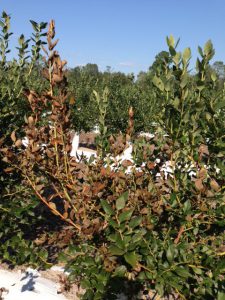
After further discussions with Dr. Phil Brannen, I was probably overzealous with my previous recommendation on Botryosphaeria stem blight during the fall season. I had previously recommended application of a contact and systemic fungicide in the field, such as Captan & Quash or Captan & Indar, etc. It won’t hurt anything if you have already applied them, however, discussions with Dr. Brannen have led me to believe that they are potentially unnecessary and likely ineffective against this particular disease this time of year, particularly if the pathogen has come in at the crown/base of the plant.
The recommendation for this disease in the spring season has not changed. If you have cold injury at the tips of the blueberry stems and you see continued brown discoloration from the tip down, this could potentially be Botryosphaeria stem blight disease. In this situation, it is recommended to hand-prune the stem back 12-18 inches below the brown discoloration, if possible, and then apply a broad spectrum fungicide like Pristine.
Research in grapes have demonstrated that fungicides can be effective against this disease after pruning wounds have been made to the vine. This is why we currently believe there is some merit in applying fungicides after post-harvest hedging practices in blueberries, preferably making the application during the hedging process or immediately after. Fall fungicide applications will still help with leaf spot diseases, such as rust. We still want to provide more research and solutions for this disease in the field. We have been working diligently this summer on some field trials at the Blueberry Research Farm in Alma, Georgia. One trial included hedging southern highbush blueberry, cultivar Star, and then testing different isolates of Botryosphaeria species as well as noting natural disease incidence. Fungicide applications were made right after hedging and the efficacy of these fungicides were assessed. The good news is that we are seeing some differences among treatments in the data. Preliminary results are forthcoming.